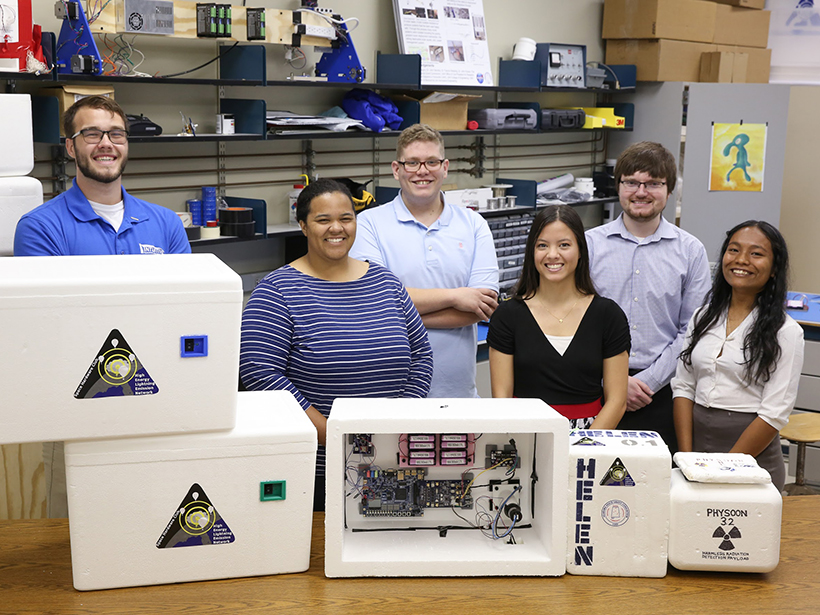At the University of Alabama in Huntsville, there’s a small but dedicated group of students constantly on the lookout for thunderstorms. This cohort of science and engineering majors plans to launch a quartet of balloons high into the atmosphere this year, with the goal of detecting flashes of gamma rays and particles. These elusive bursts, which are associated with less than 1% of lightning strikes, aren’t well understood.
The Nearby Version
“There are two types of gamma ray bursts we know of,” said Christopher Helmerich, an atmospheric physicist at the University of Alabama in Huntsville. There are the ones associated with distant black holes and neutron stars, and there are those that occur within Earth’s atmosphere. Helmerich, a first-year physics graduate student, is leading a group of undergraduates studying terrestrial gamma ray flashes, the closer-to-home version.
Terrestrial gamma ray flashes are created when electrons within thunderclouds are accelerated to nearly the speed of light by strong electric fields. “The energy density of lightning is one of the highest on Earth,” said Doug Rowland, a physicist at Goddard Space Flight Center in Greenbelt, Md., not involved in the research. “You get these intense electric fields.”
Those electrons then crash into air molecules, producing gamma rays and also electrons, neutrons, and positrons, an amalgam known as terrestrial gamma ray flashes. “It’s a whole sea of particles,” said Helmerich.
“Terrestrial gamma ray flashes can go up, down, or sideways.”
First detected by instruments aboard a satellite in the 1990s, terrestrial gamma ray flashes have also been spotted from an airplane and the International Space Station. But blink and you’ll miss them because they’re extremely fleeting—they last just thousandths of a second.
Other researchers have attempted to pin down the locations of terrestrial gamma ray flashes in the sky, but measurement uncertainties have remained around several kilometers. That’s largely because most detection platforms, for example, satellites, look down on the phenomenon from far above.
Helmerich and his colleagues believe they can do much better. “We hope to get anywhere from about 100 meters to about 1 kilometer,” said Helmerich.
Determining precisely where terrestrial gamma ray flashes occur will help constrain models of their formation. Pinpointing the origin of a terrestrial gamma ray flash can “provide insight into what region of the thundercloud the terrestrial gamma ray flash is formed in and what mechanisms play a role in its creation,” said Helmerich.
It’s believed that the flashes emanate away from lightning. Terrestrial gamma ray flashes can go “up, down, or sideways,” said Helmerich.
Student Project
In 2017, Helmerich and roughly 10 other University of Alabama in Huntsville students started the High Energy Lightning Emission Network (HELEN) project. (They work under the umbrella of the University of Alabama in Huntsville’s Space Hardware Club, an organization that gives students hands-on experiences with rocketry, satellites, and high-altitude balloons.)
The HELEN team—composed of students majoring in aerospace engineering, physics, computer engineering, and mechanical engineering—meets once a week to design, build, test, and launch payloads of instruments to measure terrestrial gamma ray flashes. One goal is to better understand where these flashes form in storm clouds, which might shed light on why they’re so rare.
Helmerich and his colleagues use helium-filled balloons to hoist payloads consisting of a particle detector, electric field sensor, camera, data recorder, and GPS unit. (Some of the equipment is purchased off the shelf, and some is custom designed. Together, it all weighs less than 2.7 kilograms, a Federal Aviation Administration limit.)
The balloons, measuring roughly 2 meters in diameter when they’re launched, are designed to ascend roughly 30 kilometers into the atmosphere, where they expand by up to a factor of 125 in volume. Eventually, they pop. A parachute then inflates and brings the equipment—and the recorded data—safely back to Earth.
So far, the students have conducted three test flights, each one consisting of one balloon and its payload. This year, the students plan to release a quartet of balloons, each with its own payload, roughly simultaneously into a large thunderstorm. Having measurements from multiple locations will allow the team to essentially triangulate the position of the terrestrial gamma ray flashes.
The first launch with all four balloons will most likely occur in spring or summer, said Helmerich, because the thunderstorm season in northern Alabama runs from March through August.
This work was presented in December at AGU’s Fall Meeting in San Francisco, Calif.
—Katherine Kornei (@katherinekornei), Freelance Science Journalist
Citation:
Kornei, K. (2020), Students launch balloon-borne payloads into thunderstorms, Eos, 101, https://doi.org/10.1029/2020EO139231. Published on 28 January 2020.
Text © 2020. The authors. CC BY-NC-ND 3.0
Except where otherwise noted, images are subject to copyright. Any reuse without express permission from the copyright owner is prohibited.

